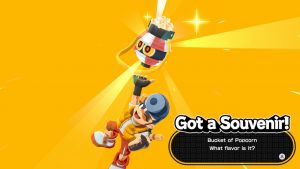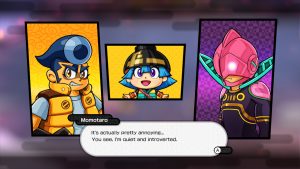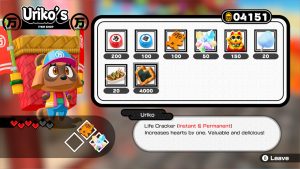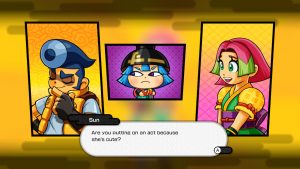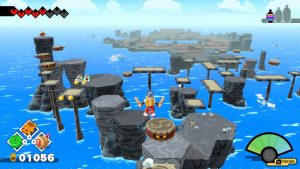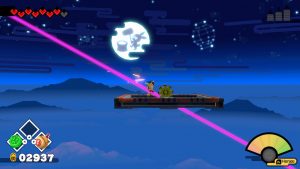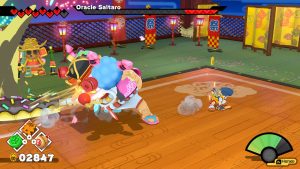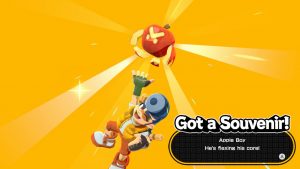
If you ask people who grew up in a specific gaming generation, Konami was one of the legends of the video game industry. It produced numerous franchises such as Contra, Castlevania, Metal Gear, Silent Hill, and even many successful licensed games such as their Teenage Mutant Ninja Turtles games. Ultimately, talent and leadership are what makes a company, and the company has had multiple exoduses that resulted in the formation of other talented companies founded by ex-Konami employees. These include Treasure (Gunstar Heroes, Light Crusader, Sin and Punishment: A Successor to the Earth), ArtPlay (Bloodstained: Ritual of the Night), Kojima Productions (Death Stranding) and GoödFeël. GoödFeël in particular was founded by former Konami programmer, Goemon producer/director and Ebisumaru namesake, Etsunobu Ebisu. It started out making Japan-only educational games such as English Training and Training Quiz for about three years, before transitioning into action games with a light-hearted feel.
GoödFeël is probably best known for their Nintendo-published games, of which there are quite a handful, including Yoshi’s Woolly World, Kirby’s Epic Yarn, Wario Land: Shake It! and Princess Peach: Showtime!
In addition to those, however, GoödFeël has developed a few games that were not published by Nintendo. These include the company’s early educational titles, plus two action games at time of writing this article: Monkey Barrels and Bakeru. Monkey Barrels is a low-mid budget top-down twin-stick shooter involving monkeys. Bakeru, meanwhile, is a possible spiritual successor to the Goemon series with a style of its own.

Basically, Bakeru is a combat-heavy 3D platformer about a raccoon dog (“tanuki” in Japanese) who transformed himself into a human boy, with a tiny girl living in his hair, who uses a drum and drumsticks to fight an army of ogres and masked dancers as well as anthropomorphic lanterns, watermelons, water balloons and snowballs, led by an extremely eccentric egotistical kabuki-themed clown who loves to graffiti his name everywhere. It takes place in an anachronistic, cartoony version of ancient Japan in which vending machines, roller coasters, cruise ships and giant robots all exist, as well as Japanese fairy tale protagonists. Along the way, he also learns random trivia facts from a creature named Scoop, who is dressed as the 
Some people might call Bakeru the most Japanese thing that could possibly exist, which might be why it took an extra year to be released worldwide after its 2023 release on Switch. But in 2024, it received English and Chinese translations in an international release on Switch as well as Steam, which even included difficulty tweaks and some reworked attack moves.
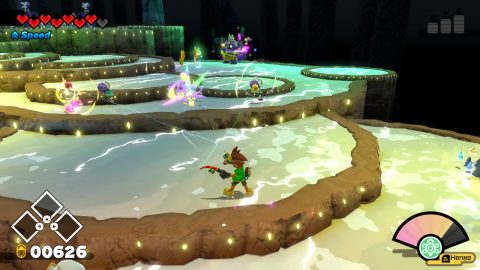
The story is basically that someone named Oracle Saitaro has used some kind of magic festival to brainwash traditional Japanese fairy tale heroes into working for him. Fighting fairy tale heroes who are either brainwashed or simply want Bakeru to prove himself in battle, earns Bakeru the ability to briefly use the hero’s power. Eventually, Bakeru earns a ship in the form of a flying teapot, and starts rescuing the captured Nanakusa Girls as well as finding hidden tanukis, both of whom end up living on his ship.
Now, let’s talk about the gameplay itself. Bakeru is a 3D platformer, but it’s also very combat heavy. So much so that it arguably could also be considered a type of beat-em-up. So, let’s start with the combat.

There’s a lot of depth to the combat, with a variety of offensive and defensive moves that can be performed. Much of the combat operates on a “left hand/right hand” system, in which two buttons are used to swing the drumstick in your left or right hand. This has a real purpose: pressing the two buttons back and forth results in you attacking rapidly and homing in on enemies quickly. It’s great for clearing out a big group. If you simply press the same button repeatedly, you don’t get that benefit.
You can also swing both drumsticks at the same time for double damage in exchange for a cooldown. In addition to that, you can charge up one or both drumsticks to perform moves such as a quick charge that knocks out enemies in a straight line, a jumping spinning slash that performs multiple hits on a single enemy and a ground pound.

Defensively, you can block attacks with your drum, as well as block with perfect timing to deflect projectiles or stun enemies. Blocking too many attacks in too short a time temporarily breaks your drum. Finally, you can dash and perform quick dodges. Dodging and then hitting an attack button results in you zipping right back at the enemy to hit them.
Those are your regular moves. Early on, you also earn the ability to briefly transform into versions of yourself that have the boss’s primary ability: extreme strength, a yoyo that hits medium distance enemies in rapid succession, or shooting enemies far away. All of these help tremendously in specific types of situations, especially as things get tricky much later on. It’s still possible for a skilled player to defeat any group of enemies without using the transformation abilities, but they can really drop the game’s difficulty.

Enemies start out very basic, but eventually start to introduce new types that can’t be attacked simply by wailing on them with your sticks. For example, one enemy armed with a wooden sword can be stunned with perfect blocking, caught off guard with a quick perfect dash, hit with any of Bakeru’s transformed forms to be taken out quickly, or knocked down with the straight-line charge attack, then attacked while it’s lying down. Pretty much any combat situation has multiple solutions! Enemies can also be defeated by each other as well as the environment, which is sometimes deliberately set up for comedy.
Bakeru is, however, a platformer. While enemies often appear in large and even tricky groups, it’s still possible to run past most enemies easily rather than fighting them. If you fight them all to rack up coins, and also try to find all the collectibles, levels will often take 15-20 minutes. Even if you avoid most enemies, levels aren’t short! There are also over 60 of them.
Level design has a huge amount of variety. Taking place across many of Japan’s prefectures and even going to locations such as the ocean and outer space, levels have a great variety of scenery and obstacles. Such as a mountainous region where some of the mountains spin around. A town with houses that can be climbed and even rotated to make them function like bridges. A cruise ship, traditional Japanese castles, a beach with a giant sand castle, construction sites and more. One level has giant triangle-shaped houses that roll down the street like giant logs and can squash you. But later, you have to enter one, and it rolls around while you’re in it! Another level, set in a town, has a street which is arranged like the inside of a pachinko machine, complete with giant bumpers and balls.

A large chunk of the levels have gimmicks. Some are racing or shooting levels, in which you enter a box-shaped dog-themed vehicle, and then drive, ski or fly through the air. There are also auto-scrolling levels as well, and a level in which you’re required to beat every enemy to unlock the exit.
The goal of most levels is to break three glowing lanterns that are locking the exit. There’s usually more than three lanterns in case you find some of them hard to get to, giving you some leeway in choice. Once the exit is unlocked, you run up to it and beat on it with your drumsticks.
The levels also have many collectibles. Scoop, the trivia dispenser, shows up five places in each level, and besides that, there are three capsules that contain souvenirs that probably did not exist in ancient Japan. Some of these can be tricky to reach, while others are tricky to find. Some require the use of Bakeru’s first transformation form: ability to shrink to enter small places. All these collectibles end up inside your ship, which you can enter on the map screen to walk around, buy upgrades for the giant robot boss fights, and talk to the inhabitants.

If you find the levels to be too hard, there’s a salestanuki that sells you all sorts of items ranging from stock items to instant consumables. These include a shield to block all damage, an item that instantly refills your life upon running out, a fireworks-themed smart bomb, speed ups and strength ups that last the entire level and turn boss fights into a joke, a cat figurine that causes enemies to drop more money when beaten, life refills and up to three maximum life increases. Bakeru can be a rather easy game for skilled gamers if they use all the salestanuki’s items, but in the later levels, it can provide a great deal of challenge if they choose not to. Think of the items and transformation forms as being a difficulty selector of sorts. They’re never required, but they can help a lot.
The game is fairly generous with checkpoints as well. Combine all that with the infinite lives, the fact that you keep all collected items even if you quit mid-level, and the fact that the only penalty for death besides being sent to a checkpoint is 10% of your money or 100 coins, whichever is lesser, and the game can be fairly forgiving.
The other gameplay element is the giant robot battles. Similar to Goemon, there are a few levels where your teapot ship transforms into a giant robot because Japan. These play out like boxing matches, where the left hand/right hand system is still in effect. You can hold a button to charge up an extended punch to hit further away. You can block. There are special attacks which can be earned over time, and you can also use the dash button to do a dodge in any direction. Keeping in with the silly boxing theme, the boss arena has boxing ring-like ropes surrounding it that you can bounce off of, and there’s even an offscreen announcer that counts to ten when the boss gets knocked down.

The game’s music is a mixture of traditional Japanese music and instruments, and modern musical genres and instruments, just like Goemon. A lot of it is catchy, though most music is recycled across multiple levels. There’s much less music than in, say, the Nintendo-published GoödFeël games, which tended to have a unique song for every level and every boss fight. Aside from the music itself, the drumstick-based combat is musical in a way – each hit plays the sound of a taiko drum being hit, and there’s also a different type of drum hit that plays every time you reach a checkpoint.
Bakeru feels like it’s trying to be as “Japan” as possible, with its use of elements from throughout the country’s history and culture both past and present. Sometimes it can feel almost forced, like when Bakeru says at the beginning of a boss fight, “It’s Musashi and Kojiro! They’re swordsmen from history!”
Yes, Miyamoto Musashi and Sasaki Kojiro were brought back from the dead by Oracle Saitaro simply to put people from actual Japanese history in there. There’s even humor that only those very familiar with Japanese culture are likely to understand, such as the fairy tale characters having personalities that are quite different from their official canon, or the visible “rabbit pounding mochi on the moon” in the background of one nighttime scene.

Part of the joke is also that the rabbit is actually one of the game’s “dancer” enemies in a rabbit outfit.
The game is, of course, aimed at a Japanese audience first and foremost, and was most likely made without international audiences in mind. Many of the facts that you learn from Scoop are about life in Japan or its history, such as how people used to work half-days on Saturdays before they finally started getting the full day off. In English, the facts always say, “In Japan,” before telling these things, since they’re being told to a non-Japanese audience.
This aim also results in a translation that might be a bit too literal at times. The introduction has Bakeru narrating a story, saying that it takes place in “a different Japan from the one you live in.” Even in English. The translation issue even extends to a joke that only makes sense in Japanese. One of the tanukis you can summon to live on your teapot airship has a line of dialog where he explains that he’s learning English, and asks if “You is tanuki” is correct grammar. The thing is, he is already speaking perfect English, then asks you if a very ungrammatical sentence is proper English! If you play in Japanese, he says in Japanese that he is learning English, and asks if “You is tanuki” (spelled using katakana) is correct English.

There’s also an issue that parents might want to be aware of, caused by the translation and cultural differences. Some of Scoop’s trivia facts are sometimes vulgar and questionable. A few talk about things such as the existence of a Manneken Pis statue, the possibility of sumo wrestlers considering seppuku, and the urinary glands of a sea creature. If you don’t know what a Manneken Pis statue or seppuku are, search those up right now and decide if those are things you want your kid to see mentioned in a video game.
Some trivia is even inaccurate – one is the myth that stink bugs knock themselves out from their own smell, another explains what Cafe au Lait Day is, but claims it’s observed on August 1st instead of its actual date of February 17th, and another claims that a Japanese inventor invented nosepieces on glasses (this one is tricky, as Japanese inventors influenced the design of nosepieces which led to their modern form, but they did not invent the actual concept of a glasses nosepiece).
That said, other trivia facts that seem too weird to be true actually are verifiably true, according to internet searches. Japan really does have an underwater mailbox that divers retrieve mail from. Jellyfish stings really do make you severely allergic to natto. It really is possible to fill a plastic bag with water and hold it over fire without it popping. And holding a plastic bottle under your left arm really does clear up nasal congestion! It’s a shame that these bizarre true facts had a few verifiably false ones mixed in. GoödFeël has a history of making educational games, so they should probably know better!
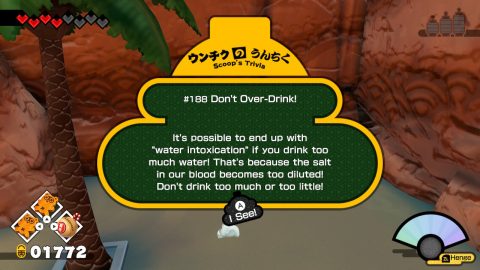
This is actually true. People have actually died from this. Look it up!
Some other possible criticisms of the game can be the pacing of levels due to their long length, and its use of fences that act like invisible walls. There are also a few (typically only for getting collectibles) moments where you have to carefully judge your position in 3D space while jumping, which is exactly the kind of thing that many people find difficult in 3D platformers. There’s also framerate issues in the Switch version, in which the game frequently drops frames and rarely meets its goal of 60.
Perhaps if Nintendo had published this game as well, they might have recommended a few tweaks to the design to avoid some of these issues. That said, Bakeru still has a large amount of the design polish that GoödFeël’s other games show as well, and fans of their other action games might find a lot to like here. If nothing else, Bakeru is the result of GoödFeël having full freedom to make what they want, which is essentially a spiritual successor to one of Konami’s franchises. Fans of 3D platformers, beat-em-ups, or those looking for something light-hearted but action-based might find it interesting. Just know that if your kids play it, they might later tell you how they just learned that crayfish pee from their heads.













